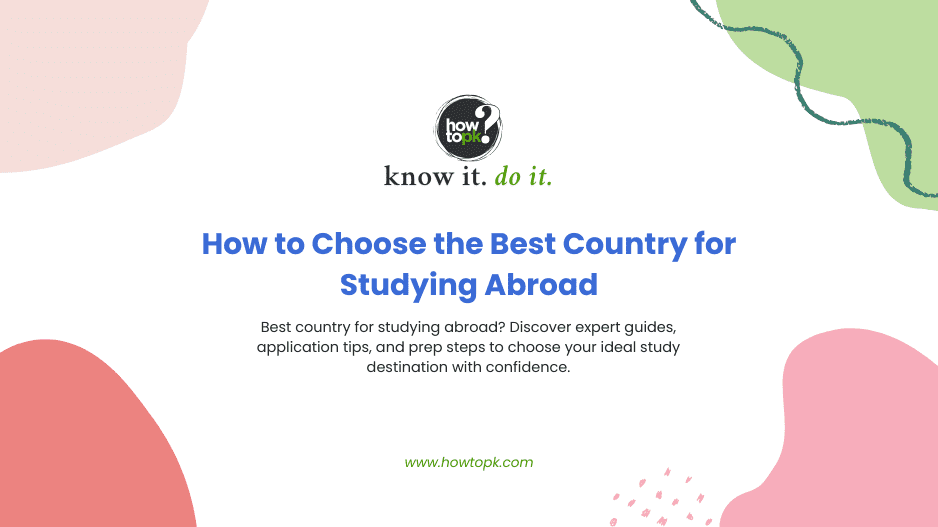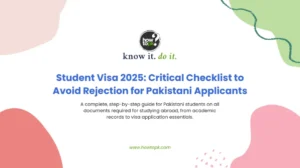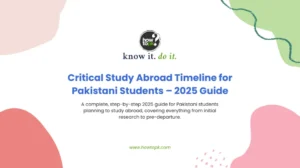Choosing the best country for studying abroad is a journey that involves much more than simply picking a destination off a map. It’s a process that asks you to look inward and outward at the same time, weighing your personal ambitions against practical realities. The first step is always about understanding yourself: your academic interests, career goals, and what you hope to gain from the experience. This means asking honest questions about your field of study, the kind of environment where you thrive, and whether you see yourself working abroad or returning home after graduation.
Step 1: Understand Your Goals and Motivations
Before you start looking at countries or universities, take a step back and reflect on your personal reasons for wanting to study abroad. This self-assessment is crucial because it will shape every decision you make along the way.
Start by asking yourself what you hope to achieve. Are you aiming for a specific career, looking to gain international experience, or hoping to immerse yourself in a new culture? Write down your answers to questions like:
- What subject or field am I passionate about, and why?
- Do I want to work in this field internationally, or do I plan to return to Pakistan after graduation?
- Am I seeking a research-focused program, practical training, or a mix of both?
- How important are factors like campus life, extracurricular activities, or the chance to travel?
Be honest with yourself. If you’re unsure, talk to family, teachers, or professionals in your field. Sometimes, discussing your ideas out loud can help clarify your thinking. Remember, your motivations are the foundation for every choice you’ll make in this process.
Step 2: Identify Your Academic and Career Priorities
Once you have a clear sense of your goals, it’s time to match them with the right academic environment. Different countries and universities have unique strengths, and it’s important to find a place that aligns with your ambitions.
Start by researching which countries are recognized for excellence in your chosen field. For example, Germany is renowned for engineering, the UK for business and law, and Australia for environmental sciences. Don’t just rely on overall university rankings—look for subject-specific rankings and consider factors like:
- The expertise and reputation of faculty members in your area of interest.
- The availability of research facilities, labs, or industry partnerships.
- Opportunities for internships, work placements, or hands-on projects.
- The flexibility of the curriculum—can you tailor your studies to your interests?
It’s also wise to look at graduate outcomes. Find out where alumni from your target programs are working now. Are they in roles or companies you aspire to join? This can give you a realistic sense of what to expect after graduation.
Step 3: Consider the Cost ofTuition, Living, and Hidden Expenses
Studying abroad is a significant financial commitment, and costs can vary dramatically depending on your destination. To avoid surprises, break down all potential expenses in detail.
Start with tuition fees. Public universities in some countries, like Germany and Norway, offer low or even free tuition, while others, such as the UK or the US, can be quite expensive. Next, research the cost of living in your target cities. This includes rent, food, transportation, utilities, and health insurance. Remember that big cities are usually more expensive than smaller towns.
Don’t forget about hidden costs. These can include:
- Application and visa fees.
- Airfare and travel expenses.
- Study materials, books, and supplies.
- Personal expenses, such as clothing, phone plans, and entertainment.
Create a detailed budget for each country you’re considering. Use online calculators or cost-of-living comparison websites to get accurate estimates. Factor in currency exchange rates and potential inflation, as these can affect your expenses over time.
Look into scholarships, grants, and financial aid. Many universities and governments offer scholarships specifically for Pakistani students. Some countries also allow international students to work part-time, which can help offset living costs. Make a list of all available funding options and note their application deadlines.
Step 4: Research Language and Cultural Fit
Language and culture play a huge role in your overall experience abroad. Even if your program is taught in English, daily life might require you to use the local language.
Check the language of instruction for your chosen programs. If it’s not English, find out what language proficiency tests are required and whether you’ll need to take language courses before or during your studies. Some universities offer preparatory language programs for international students.
Consider how comfortable you’ll be with the local culture. Research the country’s customs, food, religious practices, and social norms. Will you be able to find halal food easily? Are there mosques or prayer facilities nearby? How open is the society to international and Muslim students?
Connecting with current Pakistani students or alumni can give you valuable insights. Look for student associations, social media groups, or university forums where you can ask questions about daily life, challenges, and tips for adjusting.
Step 5: Evaluate Safety and Quality of Life
Your safety and well-being are just as important as your academic goals. Research the safety record of your target countries and cities. Look at crime rates, political stability, and the general attitude toward international students.
Check the quality of healthcare and whether you’ll have access to affordable medical services. Some countries require you to purchase health insurance as part of your visa application. Find out what’s covered and how to access care if you need it.
Consider the climate and environment. If you’ve never experienced harsh winters or long periods of darkness, think about how you’ll adapt. Some students find it challenging to adjust to new weather conditions, so plan ahead by packing appropriate clothing and learning about local transportation options.
Look into the availability of support services for international students. Many universities offer counseling, academic support, and emergency assistance. Knowing what help is available can give you peace of mind.
Step 6: Understand Visa and Immigration Policies
Visa and immigration rules can make or break your study plans. Each country has its own requirements, processing times, and restrictions.
Start by researching the student visa process for your chosen countries. Find out:
- What documents are required (e.g., admission letter, proof of funds, health insurance).
- How much money you need to show in your bank account and for how long.
- Whether you need to attend an interview at the embassy or consulate.
- How long the visa is valid and whether it can be extended.
Check if you’re allowed to work part-time during your studies and how many hours per week are permitted. Some countries also offer post-study work visas, which let you stay and work after graduation. This can be a major advantage if you’re hoping to gain international work experience or apply for permanent residency.
Start your visa application as early as possible. Gather all required documents, make copies, and keep everything organized. Delays are common, so build in extra time to avoid last-minute stress.
Step 7: Explore Career and Post-Graduation Opportunities
Think beyond your degree and consider your long-term career prospects. Research the job market in your target countries for your field of study. Are there plenty of opportunities for graduates? What are the typical starting salaries?
Find out if your chosen country allows international students to stay and work after graduation. Some countries, like Canada and Australia, have clear pathways to post-study work visas and even permanent residency. Others may have stricter rules or limited options.
Look for universities with strong career services, internship programs, and connections to local employers. These can help you gain valuable work experience and build a professional network while you study.
Read alumni success stories and reach out to graduates from your program. Ask about their experiences finding jobs, the challenges they faced, and any advice they have for new students.
Step 8: Shortlist Countries and Compare
By now, you should have gathered a wealth of information. It’s time to narrow down your options and make a side-by-side comparison.
Create a table or spreadsheet listing your top 3–5 countries. Include key factors such as:
- Academic reputation in your field.
- Tuition and living costs.
- Language and cultural fit.
- Safety and quality of life.
- Visa and work policies.
- Scholarships and financial aid.
- Career and post-graduation opportunities.
Involve your family in this process. They may have concerns or preferences you haven’t considered, and their support can be invaluable. Be open to feedback and willing to adjust your priorities if needed.
Step 9: Research Universities and Programs
Once you’ve chosen your countries, dive deeper into specific universities and programs. Each institution has its own strengths, admission requirements, and application processes.
Start by making a list of universities that offer your desired program. Visit their official websites and read through the course descriptions, faculty profiles, and research opportunities. Pay attention to:
- Admission requirements, including grades, standardized tests, and language proficiency.
- Application deadlines, which can vary widely between countries and universities.
- Required documents, such as transcripts, letters of recommendation, and personal statements.
- Course structure and flexibility—can you choose electives or specialize in certain areas?
- Support services for international students, including orientation programs, academic advising, and counseling.
Attend virtual open days, webinars, or information sessions. These events are a great way to ask questions, meet faculty and current students, and get a feel for the university’s culture.
Step 10: Connect with Current Students and Alumni
First-hand experience is invaluable when making such a big decision. Reach out to current Pakistani students and alumni from your shortlisted universities.
Use social media platforms, LinkedIn, or university international offices to find contacts. When you connect, ask about:
- The application and admission process—what was challenging, and what went smoothly?
- Adjusting to life abroad—what were the biggest surprises or difficulties?
- Academic expectations—how do teaching styles and assessments differ from Pakistan?
- Tips for managing finances, finding accommodation, and building a social network.
Most students and alumni are happy to share their experiences and offer advice. Their insights can help you avoid common pitfalls and prepare for the realities of studying abroad.
Step 11: Prepare for Applications and Documentation
The application process can be complex and time-consuming, so it’s important to stay organized. Each country and university will have its own requirements, but you’ll typically need:
- Academic transcripts and certificates, translated into English if necessary.
- English proficiency test scores (such as IELTS or TOEFL).
- Letters of recommendation from teachers or employers.
- A statement of purpose or motivation letter explaining why you want to study there.
- A valid passport and recent photographs.
- Proof of funds, such as bank statements or scholarship letters.
- Health and travel insurance documents.
Start gathering these documents early. Some, like police clearance certificates or medical exams, can take several weeks to process. Make digital and physical copies of everything, and keep them in a safe, easily accessible place.
Double-check application deadlines and submit your materials well in advance. Late or incomplete applications are a common reason for rejection.
Step 12: Plan for Life Abroad
Once you’ve received an offer, it’s time to prepare for your move. This stage involves both practical arrangements and emotional preparation.
Arrange your accommodation as soon as possible. University dormitories are often the easiest option for first-year international students, but private rentals or homestays can also be good choices. Research the pros and cons of each and consider factors like location, cost, and facilities.
Set up health insurance and make sure you’re up to date on any required vaccinations. Some countries have specific health requirements for international students.
Open a bank account in your destination country, if possible. This will make it easier to manage your finances and receive money from home.
Start packing well in advance. Make a checklist of essentials, including clothing for the local climate, adapters for electronics, and any special items you might need (such as halal food or prayer mats). Don’t forget important documents and emergency contact information.
Familiarize yourself with local transportation, emergency services, and support networks. Many universities offer orientation sessions for new international students—attend these to get practical advice and meet new friends.
Step 13: Prepare for Challenges and Embrace the Experience
Studying abroad is an exciting adventure, but it can also be challenging. Common issues include homesickness, culture shock, language barriers, and academic differences.
Stay connected with family and friends back home through regular calls or messages. Join student groups, clubs, or cultural associations to build a support network in your new country.
If you’re struggling with language or academic expectations, seek help from university support services. Most institutions offer tutoring, counseling, and workshops to help international students succeed.
Be open to new experiences and willing to step outside your comfort zone. Every challenge is an opportunity to learn and grow. Remember, it’s normal to feel overwhelmed at times—what matters is how you respond and adapt.
Sample Comparison Table
| Country | Tuition Fees | Living Costs | Language | Work Rights | Post-Study Visa | Scholarships | Safety/Quality of Life |
|---|---|---|---|---|---|---|---|
| UK | High | High | English | 20 hrs/week | 2 years | Many | High |
| Canada | Medium | Medium | English/French | 20 hrs/week | 3 years | Many | Very High |
| Germany | Low/Free | Medium | German/English | 20 hrs/week | 18 months | Some | High |
| Australia | High | High | English | 20 hrs/week | 2-4 years | Many | High |
| Turkey | Low | Low | Turkish/English | 24 hrs/week | 1 year | Some | Medium |
Common Issues Faced During Each Step and How to Troubleshoot Them
Choosing and preparing for study abroad is a complex process, and it’s normal to encounter obstacles along the way. Here’s a detailed look at common problems you might face at each stage, along with practical solutions to help you overcome them.
| Step & Common Issue | Troubleshooting |
|---|---|
| 1. Understanding Your Goals – Feeling uncertain about motivations or career path | Self-reflect, talk to mentors, use career assessment tools. Don’t rush this step. |
| 2. Academic & Career Priorities – Overwhelmed by conflicting rankings | Focus on subject-specific results, make a shortlist of criteria, consult current students/alumni. |
| 3. Financial Planning – Underestimating or missing costs | Create a detailed budget, cross-check costs, apply for scholarships, consider part-time work, have a backup plan. |
| 4. Language & Culture – Language barriers or cultural adjustment | Start language learning early, use apps, learn customs, connect with Pakistani student groups. |
| 5. Safety & Quality of Life – Safety concerns or environmental adaptation | Research safety stats, choose secure housing, know emergency contacts, attend orientations. |
| 6. Visa & Immigration – Delays or complications | Apply early, double-check requirements, keep document copies, track progress, contact embassy if needed. |
| 7. Career & Post-Graduation Opportunities – Uncertainty about job prospects | Research job markets, attend career fairs, network via LinkedIn, seek internships. |
| 8. Shortlisting & Comparison – Difficulty narrowing choices | Use comparison tables, involve trusted advisors, revisit goals and priorities. |
| 9. University & Program Research – Confusion over requirements or deadlines | Make checklists, set reminders, contact admissions offices directly. |
| 10. Connecting with Students & Alumni – Difficulty reaching students | Use university channels, LinkedIn, social media, forums, and be polite in outreach. |
| 11. Applications & Documentation – Missing or incomplete documents | Gather early, keep copies, maintain checklist, contact authorities quickly for missing items. |
| 12. Planning for Life Abroad – Feeling unprepared for practical living | Attend pre-departure orientations, make a packing list, research local services, connect with support offices. |
| 13. Adjusting & Thriving – Homesickness, loneliness, academic stress | Stay connected to home, build local support, seek counseling if needed, give yourself time to adapt. |
By following this expanded, step-by-step guide and using the troubleshooting tips provided, you’ll be well equipped to navigate every stage of choosing the best country for studying abroad. Take your time, stay organized, and remember that every challenge is an opportunity to learn and grow.




